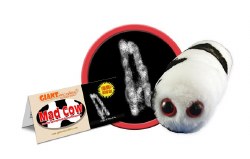Giant Microbes
Mad Cow Plush
Item Number: GMUS-PD-0480
$12.99
Giant Microbes Mad Cow (Bovine Spongiform Encephalopathy) plush
When bovine prions stampede the wrong way, everyone says Moo! (Each doll has its own unique pattern.)
Great gag gift for your favorite carnivore
Fun way to tell someone they've stepped over the line
Learn about this infamous microbial celebirty
All About Mad Cow (Bovine Spongiform Encephalopathy)
FACTS: First identified in Britain in the mid-1980's, Mad Cow disease, or Bovine Spongiform Encephalopathy (BSE), is generally thought to be the work of proteinaceous infectious particles, or prions. These inanimate amino acid chains (which are far smaller than bacteria or viruses, and are not destroyed by thorough cooking) normally twist like pretzels into a particular shape. According to theory, they can get a little crazy and twist the wrong way. Similar proteins follow the herd, go nuts as well, and congeal into long rods that ultimately inhibit brain function. (Other prion diseases include the sheep-disease scrapie; Kuru, once found in the cannibals of Papua-New Guinea; and Creutzfeldt-Jakob disease, a variant of which is believed to be Mad Cow in humans.)
Although Mad Cow prions are typically found in brains and spinal tissues, and are thought to be transmissible primarily by direct consumption, even cows and humans without a predilection for consuming nervous tissues are at risk: at processing plants, these materials can end up both in cattle feed and on your sirloin steak. (In fact, cattle feed contaminated with scrapie-infected sheep tissue is credited with spreading ovine prions into the bovine population.)
With an up-to-decades-long latency period, no cure, no treatment, and no chance of recovery, concern about BSE is no bull. Nevertheless, the risk of infection is extremely low. Strenuous efforts are being made to prevent the spread of Mad Cow, including the implementation of strict animal feed regulations and processing standards. So beef-eaters are hardly insane to keep eating - though that may make cows even madder....
COMMONALITY There have only been four confirmed cases in the USA.
From 1986 to 2001, a British outbreak affected 180,000 cattle but was contained well.
CURE There is currently no cure or vaccination for this disease.
INFECTIOUSNESS The illness only spreads if a cow that died of Mad Cow Disease is fed to other cattle.
Before the disease was researched, enormous outbreaks occurred from single cow. Nowadays, it is very easy to contain once identified.
Incubation period is anywhere between four and six years.
HISTORY In the 1980‘s The University of California discovered that samples of the infected cows had BSE
The first documented outbreaks of the disease occurred in the United Kingdom in 1986
"Bovine" means that the disease affects cows, "Spongiform" references the spongy texture of an infected brain, and "Encephalopathy" indicates that it is a disease of the brain.
Big Outbreaks:
In 1988, 421 cows were diagnosed, by 1993, 120,000 cattle were diagnosed.
FASCINATING FACTS Humans cannot contract BSE, but a vCJD from consuming infected beef
Thoroughly cooking meat will not disinfect it
Both cows and humans will not know they are infected until years later. When they start showing symptoms, death generally occurs within two weeks to six months.
In Culture:
In the film We Are What We Are, a family member succumbs to the human form of the disease
Discussed on Oprah on April 15th, 1996
UPC:846869008807







Share: